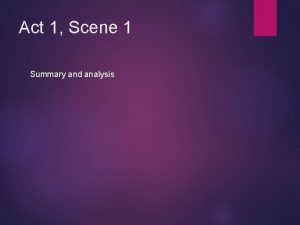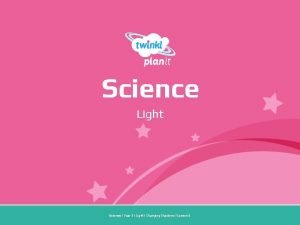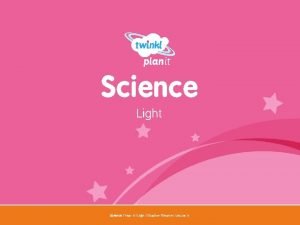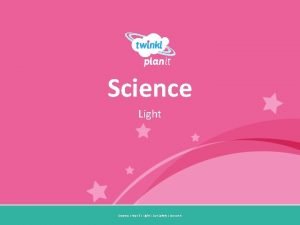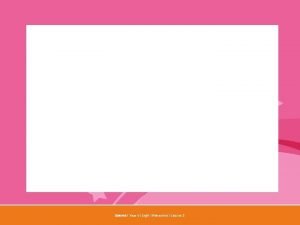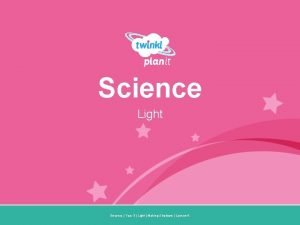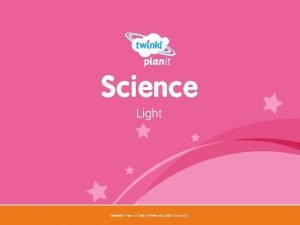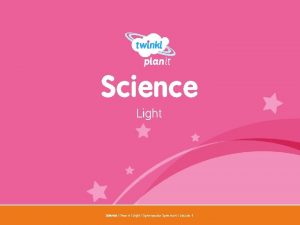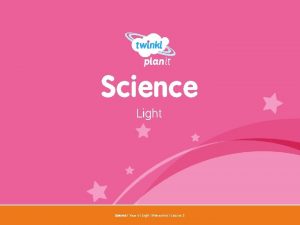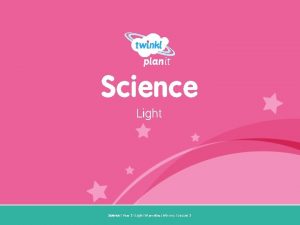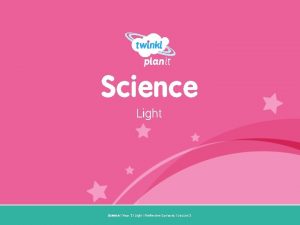Science Light Year One Science Year 6 Light














- Slides: 14

Science Light Year One Science | Year 6 | Light | Refraction | Lesson 3


• I can investigate how refraction changes the direction in which light travels. • I can understand how light is refracted. • I can investigate the effects of refraction. • I can understand the way refraction alters the direction of light.

This photo shows the effect created when light is refracted. What is happening?

These children are talking about why the straw looks broken, when they know it isn’t. Who do you agree with? Why? I think the water has bent the straw so it looks like it has broken. The light can’t travel through the glass properly and the ray of light is broken. This makes the straw look broken. Light travels at different speeds through water and glass, making the ray of light bend. This makes the straw look bent or broken. The straw is opaque and the glass is transparent, which causes light to be twisted, making the straw look bent and broken.

Watch this video to find out more about refraction While you are watching, think about: What happens when light travels from air into another transparent material, such as glass, plastic or water? How does a lens focus light?

Light waves travel at a different speed when they go through other transparent materials, such as water or glass. This causes the rays of light to change direction and bend. This is known as refraction. Refraction creates illusions. Because light bends when it travels between air and water or glass, objects seen through these materials look bent or distorted. Photo courtesy of indi. ca (@flickr. com) - granted under creative commons licence – attribution

You are going to work together to set up two investigations to explore refraction. Have a look at each investigation and predict what you think will happen. Try to explain your prediction using your scientific knowledge and understanding. Follow the instructions to set up each investigation. Record what happens and say whether your prediction was accurate or not. Come to a conclusion for each investigation, explaining what happened and why.

You will draw a horizontal arrow on a small piece of paper. Then hold the piece of paper behind a glass filled with water. What do you predict will happen? Try it out and describe your observations. Was your prediction accurate? Can you explain what happened and why, using your understanding of refraction?

You will draw a small picture on a piece of paper a smiley face or star are some examples of images you may draw. Then, place an empty glass over the top of the picture and look at your image through the side of the glass. As you watch your picture, slowly fill the glass with water. When the glass is full, you should cover the top of the glass with a saucer. What do you predict will happen? Have a go! What do you observe? What happened to the image you drew? Explain why this happened in your conclusion, thinking about refraction.

In this investigation, when you place your arrow at a certain distance behind the glass of water, it appears to point in the opposite direction. The arrow turns because the light travelled from the air, through the glass, through the water, through the back of the glass, and then back through the air, before hitting the arrow. When light passes from air through a transparent material, it refracts, causing it to bend. Because the glass is curved, it also acts a lens, focusing the rays of light. Where the light all comes together is called the focal point, but beyond the focal point the image appears to reverse. The rays of light that were bent cross each other, so that the light from the left of the arrow is now on the right, and light from the right of the arrow is now on the left. This is what causes the arrow to appear reversed.

When you filled the glass with water and placed a saucer on top, the image seemed to have disappeared. Light rays falling on the image are refracted through the glass, then the water, then back into the air. When the refracted rays are bent at different angles by adding the water, it means they can be blocked by the saucer on top of the glass. Since the rays of light cannot get through the saucer, they cannot reach our eyes and we cannot see the image. It seems to have disappeared!

• I can investigate how refraction changes the direction in which light travels. • I can understand how light is refracted. • I can investigate the effects of refraction. • I can understand the way refraction alters the direction of light.

 In what year is act one, scene one set?
In what year is act one, scene one set? Light year 3
Light year 3 Light light light chapter 23
Light light light chapter 23 Into the light chapter 22
Into the light chapter 22 Light light light chapter 22
Light light light chapter 22 One god one empire one religion
One god one empire one religion Little dog run
Little dog run One king one law one faith
One king one law one faith One empire one god one emperor
One empire one god one emperor One team one plan one goal
One team one plan one goal See one do one teach one
See one do one teach one One price policy
One price policy One face one voice one habit and two persons
One face one voice one habit and two persons Studiendekanat uni bonn
Studiendekanat uni bonn Asean tourism strategic plan
Asean tourism strategic plan
